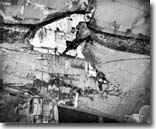
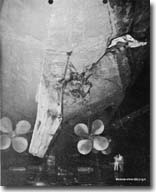
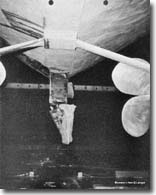
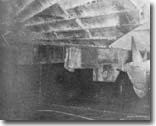
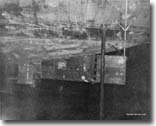
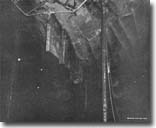
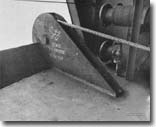
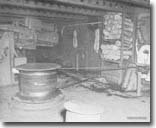
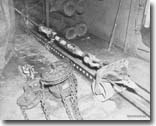
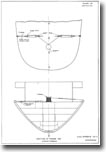
If you can see this text here you should update to a newer web browser
Normal | Highlight & Comment Highlighted Text will be in Yellow, but there are none yet
|
RESTRICTED
1. A deep running aircraft torpedo detonated at about frame 194, just forward of the rudder, while INTREPID was making a port turn. Structural damage and flooding were moderate, but the rudder and steering gear were damaged beyond use or repair and the fairing piece over the counterbalance portion of the rudder was blown off (Photos 73, 74 and 75). The effect of the damage on ship control was equivalent to maintaining 6 1/2° left rudder. After considerable experimentation, including measures to reduce the drag aft and to provide sail area forward, the ship was able to proceed from Truk to Pearl Harbor using main engines for steering. While in drydock at Pearl Harbor, the damaged rudder was removed with the expectation that this would facilitate controlling the ship by use of the engines during the trip to San Francisco. 2. In order to reduce the tactical diameter of the CV9 class, the hull was designed with little deadwood, and directional stability was provided primarily by the rudder. After leaving Pearl Harbor with all rudder area removed, INTREPID was unmanageable. It was impossible to steady on any course and at times the ship would swing uncontrollably through 360° . Therefore, INTREPID was towed back to Pearl Harbor and again placed in drydock, where a nonwatertight fairing patch was installed over the damaged shell plating (Photo 76) and a jury steering arrangement was provided. 3. An auxiliary centerline fin, equal in area to the original rudder, was installed. A 100 square foot section at the after end of the fin was hinged to serve as a jury rudder; this hinged portion having about 20% of the area of the original rudder (Photos 76, 77 and 78). The jury rudder could be rotated through a maximum angle of 20° right or left. It was controlled by wire cables which passed through a protecting pipe outboard of the shell and over sheaves at the deck edge on the fantail (Photos 77, 78 and 79). The ends of the rudder cables were secured to gun-tackle purchases, the running ends of which were taken to the after capstan (Photos 80 and 81).
|
|
RESTRICTED
4. It was originally intended that the jury rudder would provide directional stability and that steering would be done primarily by the engines. After leaving Pearl Harbor, steering with the engines was difficult and yaw could not be reduced below 40° to each side. It proved more satisfactory to overcome the effect of wind by adjusting engine revolutions and to use the jury rudder for steering. Full rudder gave the effect of about 5° of the original rudder. Despite 15 to 25 knot winds, yawing was reduced to about 10° on either side. Although the capstan starting panel was not designed for continuous operation as is required for steering, frequent cleaning of the contactors prevented excessive arcing. Special arrangements for lubricating the capstan shaft were made by INTREPID. Passage to San Francisco was made at 15 knots without further difficulty.
|
SOURCE:
Transcribed by RESEARCHER @ LARGE. Formatting & Comments Copyright R@L.
Intrepid Home | Repairs in Forward Areas Home |
Ships Home | Researcher@Large Home